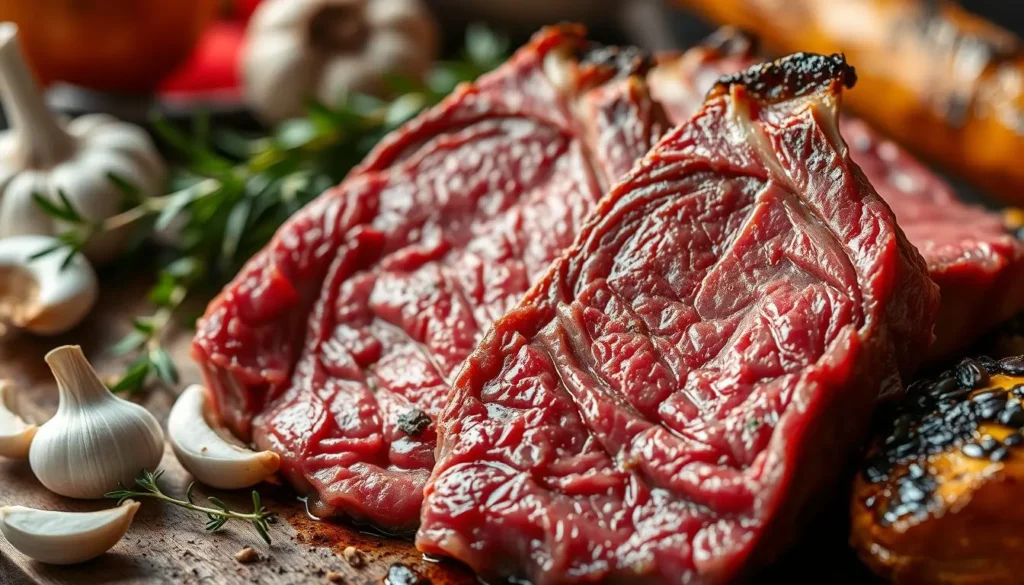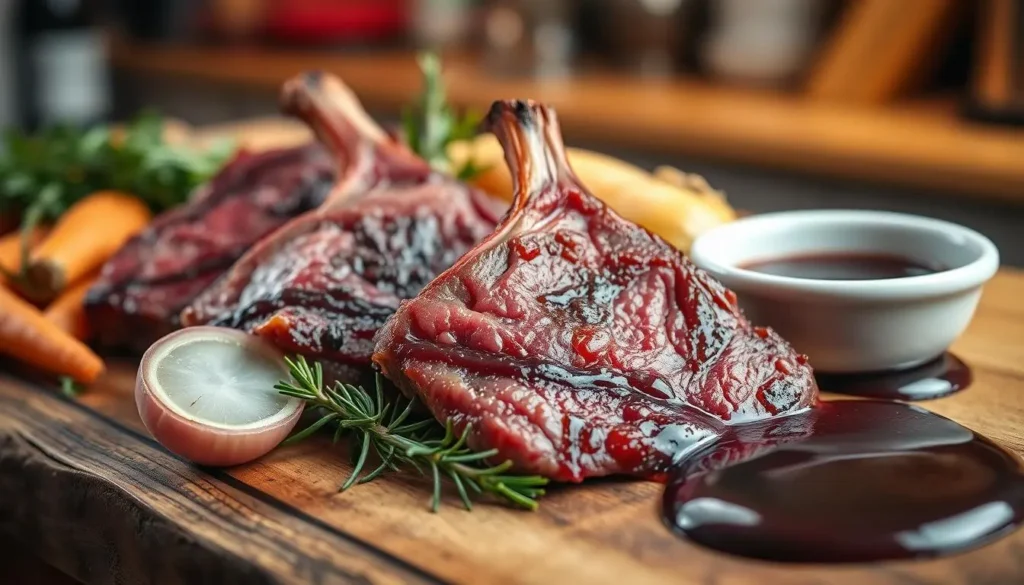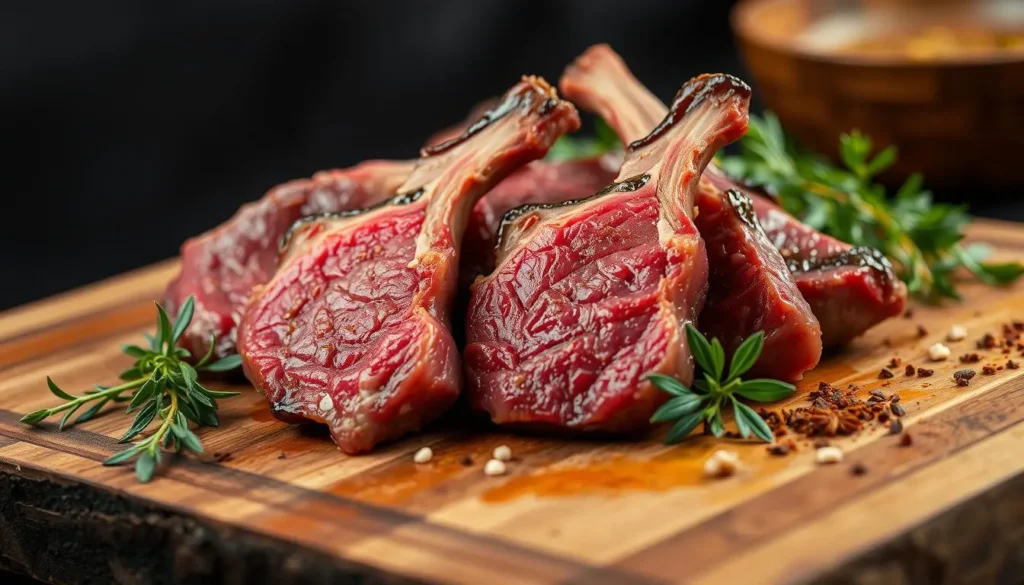Exploring fine dining often reveals beef-cheeks as a common feature. But why are they so pricey? Beef-cheeks are rare and highly valued for their rich taste and soft texture. This makes them a favorite in fancy restaurants.
There are many reasons beef-cheeks cost more. They’re not easy to find. The process of getting them ready for cooking also adds to the price. Learning about beef cheeks can help you understand why they’re so expensive.
Key Takeaways
- Beef-cheeks are a prized cut of meat known for their rich flavor and tender texture
- The high cost of beef-cheeks can be attributed to their limited availability and culinary significance
- Beef-cheeks are a staple in many high-end restaurants, contributing to their premium pricing
- The cost of beef-cheeks is influenced by factors such as processing and butchering costs
- Understanding the production and pricing of beef-cheeks can help you appreciate their value
- Beef-cheeks are a sought-after ingredient in fine dining, making them a valuable addition to any menu
- The price of beef-cheeks is a reflection of their quality and the care that goes into their production

What Are Beef Cheeks and Their Culinary Significance
Beef-cheeks come from the cow’s face, near the mouth. They are known for their rich, tender flavor. This makes them a delicacy in many cuisines. When you ask are beef cheeks good meat?, the answer is yes, they are highly prized.
Beef-cheeks are used in many dishes worldwide. They are found in traditional Mexican dishes like barbacoa and modern fine dining recipes. They are popular because they are affordable yet taste great.
Anatomical Location and Characteristics
Beef-cheeks are on the cow’s face, near the mouth. They are made of muscles that help the cow chew. This makes them tender and juicy with a rich flavor.
Historical Use in Different Cuisines
Beef-cheeks have been used for centuries in various cuisines. In some places, they are a staple, while in others, they are rare. They are used in stews, braises, BBQ, and grills, showing their versatility.
Nutritional Profile of Beef Cheeks
Beef-cheeks are not just tasty but also nutritious. They are full of protein, vitamins, and minerals. They are a great choice for anyone looking to add variety to their meals.
Why Is Beef Cheek So Expensive in Today’s Market
When you look into beef-cheeks, you might ask why is beef cheek so expensive. The cost is due to several reasons. One key factor is the limited amount of beef cheeks available. Each animal has only a few pounds of this cut. This scarcity, combined with the rising demand in fancy restaurants, makes the price go up.
Another reason is the hard work needed to process and butcher beef cheeks. This cut needs careful trimming and cleaning, which increases the cost. Also, as more people want to try beef cheeks in upscale places, the price goes up. Here are the main reasons for the high cost of beef cheeks:
- Limited supply of beef cheeks per animal
- Increasing demand in high-end restaurants
- Labor-intensive processing and butchering
- Growing popularity in fine dining establishments
To understand why is beef cheek so expensive, we need to look at the economic reasons. As more people want beef cheeks, the price will likely stay high. But for those who are willing to pay more, beef cheeks offer a special and tasty experience.
| Factor | Impact on Price |
|---|---|
| Limited supply | High |
| Increasing demand | High |
| Labor-intensive processing | Moderate |
| Growing popularity | High |
The Supply Chain Behind Beef Cheek Pricing
Beef-cheek prices are high due to a long journey from farm to table. This journey includes several stages that increase costs. The rarity of cheeks, special processing needs, and distribution challenges all play a role.
Some key factors affecting the supply chain include:
- Limited availability: With only one pair of cheeks per animal, the supply is naturally limited, making beef-cheeks a rare and sought-after product.
- Processing and butchering costs: The process of removing and preparing beef-cheeks requires specialized skills and equipment, increasing the cost of production.
- Distribution challenges: Getting beef-cheeks from the farm to the consumer can be difficult due to their perishable nature and the need for specialized handling and storage.
Understanding these factors helps us see why beef-cheeks are so expensive. As you delve into the world of beef-cheeks, you’ll discover their unique qualities and the challenges they pose. This makes them a true delicacy, with a price to match.
| Factor | Description | Impact on Price |
|---|---|---|
| Limited Availability | Only one pair of cheeks per animal | Increases price due to scarcity |
| Processing and Butchering | Specialized skills and equipment required | Increases production costs |
| Distribution Challenges | Perishable nature and specialized handling required | Increases logistics costs |
Understanding Beef Cheek Quality Grades
Are beef cheeks good meat? The answer depends on their quality grades, which affect their price. Quality is based on marbling, texture, and color. Marbling, or the fat in the meat, makes it tender and flavorful.
High-quality beef-cheeks have a fine texture and a rich, red color. The marbling level is key in determining quality. Generally, more marbling means higher quality and a higher price. Here are some common quality grades:
- Prime: This is the highest quality, with lots of marbling and a tender texture.
- Choice: This grade has less marbling but still offers good tenderness and flavor.
- Standard: This is the most common, with moderate marbling and a coarser texture.
Knowing the quality grades of beef-cheeks helps you make better choices. Whether you’re a chef or just love food, understanding beef cheeks can enhance your cooking.
The Growing Demand for Beef Cheeks in Fine Dining
Beef-cheeks are becoming more popular in fine dining menus. They have a special flavor and texture. They’re perfect for braised beef-cheeks dishes.
Celebrity chefs also play a big role. They often use beef cheeks in their recipes and shows. This has made more people interested in trying them.
Restaurant Industry Impact
Restaurants are now adding beef-cheeks to their menus. They’re prepared in different ways, like:
- Braising: cooking in liquid over low heat for a long time
- Grilling: cooking over high heat for a crispy outside
- Stewing: cooking in a flavorful broth with veggies and spices
These methods show how versatile beef-cheeks can be. They can become a standout dish in fancy restaurants.

Celebrity Chef Influence
Celebrity chefs have helped make beef-cheeks popular. Their recipes and techniques have inspired many to try beef-cheeks at home or in restaurants.
| Celebrity Chef | Beef Cheek Recipe |
|---|---|
| Gordon Ramsay | Braised Beef Cheeks with Red Wine and Mushrooms |
| Jamie Oliver | Grilled Beef Cheeks with Chimichurri Sauce |
The influence of these chefs has boosted the demand for beef-cheeks. They’re now more common in fancy restaurants.
Comparing Beef Cheeks to Other Premium Cuts
When thinking about premium beef cuts, you might ask are beef-cheeks like brisket? Both are known for their rich flavor and tender texture. But, they have their own unique differences. Beef-cheeks, like other premium cuts, provide a special dining experience.
They are often compared to short ribs or oxtail because of their similar texture and flavor. A big difference between beef-cheeks and brisket is the marbling. Brisket has more marbling, which makes it tender and flavorful.
However, beef-cheeks have a more intense, beefy flavor that many prefer. Both cuts can be slow-cooked to get a tender, fall-apart texture.
Here are some key similarities and differences between beef-cheeks and other premium cuts:
- Rich, beefy flavor
- Tender texture when slow-cooked
- Often braised or stewed to achieve tender texture
- Differences in marbling and fat content
- Unique texture and flavor profile compared to brisket
In conclusion, while beef-cheeks share some similarities with other premium cuts like brisket, they offer a distinct dining experience. Their rich flavor and tender texture make them a favorite among beef lovers.
How to Select and Purchase Beef Cheeks
When buying beef-cheeks, aim for the best quality. These cuts, also known as cheek meat, are prized for their flavor and texture. In the USA, they’re often called beef-cheek meat or simply cheeks.
Look for fresh, well-colored beef-cheeks without excess fat or connective tissue. You can find them at specialty butcher shops, upscale grocery stores, or online. Popular spots include Whole Foods, Wegmans, and online at Amazon or ButcherBox.
Here are some tips for buying beef cheeks:
- Check the meat’s origin and quality
- Opt for grass-fed or pasture-raised beef cheeks
- Compare prices across different retailers
Prices for beef-cheeks can change with the seasons. They’re often pricier during holidays or special events. But with some planning, you can find great deals on quality beef-cheeks.
By following these tips, you can find the perfect beef-cheeks for your next dish. Whether you’re a pro chef or a home cook, beef-cheeks are a delicious choice that will wow your guests.
| Beef Cheek Cut | Description | Price Range |
|---|---|---|
| Whole Beef-Cheek | A whole, untrimmed beef cheek | $10-$15 per pound |
| Beef Cheek Steaks | Thinly sliced beef cheek steaks | $15-$20 per pound |
| Beef Cheek Cubes | Cubed beef cheek meat, perfect for stews or soups | $12-$18 per pound |
Preparing and Cooking Beef Cheeks
Preparing beef-cheeks can be done in several ways to enhance flavors and textures. Braising is a favorite method. It involves cooking the beef-cheeks in liquid over low heat for a long time. This makes the meat tender and creates a rich sauce.
To braise beef-cheeks, start by seasoning the meat with herbs and spices. Then, sear it in a hot pan to get a crispy crust. Add liquid like stock or wine to the pan and simmer it. Cover the pan and bake in the oven for hours.
Here are some tips for cooking beef cheeks:
- Use a Dutch oven or heavy pot with a tight lid for even heat
- Don’t overcrowd the pan to ensure even cooking
- Let the beef-cheeks rest for a few minutes before serving to let juices redistribute
Cooking beef(cheeks is rewarding. With practice, you can make tender dishes that highlight the meat’s rich flavor. Whether you choose braised beef-cheeks or another method, slow cooking is key. It breaks down connective tissues and blends flavors.
| Cooking Method | Cooking Time | Temperature |
|---|---|---|
| Braising | 2-3 hours | 300°F (150°C) |
| Grilling | 5-7 minutes per side | 400°F (200°C) |
| Roasting | 1-2 hours | 325°F (165°C) |
The Difference Between American and International Beef Cheeks
Have you ever wondered what are beef-cheeks called in USA? In the US, they are known as beef cheeks or cheek meat. But, in other countries, they have different names. For example, in the UK, they are called beef jowls.
In the US, beef-cheeks are a luxury item found in fancy restaurants. They are loved for their tender and tasty meat. This meat is full of connective tissue, making it great for slow-cooking like braising or stewing.
Prices for beef-cheeks also vary by region. This is because of things like transportation costs, demand, and how easy they are to find. Here’s a look at the average prices in different places:
| Region | Average Price per Pound |
|---|---|
| US | $8-$12 |
| UK | $6-$10 |
| Australia | $10-$15 |
As shown, beef-cheeks cost differently in each area. So, it’s smart to check and compare prices before buying.

Maximizing Your Beef Cheek Investment
When you buy beef-cheeks, it’s key to use them wisely. Since they’re a high-end cut, why is beef-cheek so expensive is about getting value for money. Here are some tips to help you stretch your beef cheeks budget:
Portion Control Tips
- Plan your meals ahead to avoid throwing food away
- Use a food scale for exact portion sizes
- Cook in bulk and freeze leftovers for later
Storing your beef-cheeks right is also important. These simple steps will help you enjoy your beef-cheeks longer and get the most out of your premium meat purchase.
Storage Methods
To keep your beef-cheeks fresh, store them in a sealed container or zip-top bag. Make sure to remove as much air as you can before sealing. Freezing your beef-cheeks is another way to extend their shelf life.
By using these strategies, you can enjoy your beef-cheeks and feel they’re worth the cost. A bit of planning and care can make your investment in this tasty and tender meat worthwhile.
| Storage Method | Shelf Life |
|---|---|
| Refrigeration | 3-5 days |
| Freezing | 6-8 months |
Alternative Cuts and Substitutes
When beef-cheeks are too expensive or hard to find, you might ask are beef-cheeks like brisket? They share some qualities, but beef-cheeks have their own special taste and texture. Other cuts can give you a similar taste experience without breaking the bank.
Beef-cheeks and brisket are both tender when cooked slowly. But, beef cheeks have a unique flavor. If you’re looking for something else, here are some good choices:
- Short ribs, which offer a fall-off-the-bone texture when braised
- Chuck roast, a cut that becomes tender and flavorful with slow cooking
- Shank, a cut that, like beef cheeks, benefits from low and slow cooking methods
These options can give you a similar taste to beef cheeks but are more affordable. If you’re on a tight budget or just want to try something new, these cuts are worth exploring.
In cooking, being open to new cuts and methods can make your dishes better. So, if beef cheeks are too pricey, don’t worry. There are other cuts that can give you a great taste experience.
Conclusion: Is the Price of Beef Cheek Justified?
The high price of beef cheeks comes from their limited availability and specialized processing. They are also in high demand in the culinary world. Despite their cost, their unique flavor, texture, and health benefits make them a good choice for those who love to cook.
Beef cheeks are hard to find because they come from a small part of the animal. Butchers work hard to make them tender. This effort adds to their value.
Whether beef cheeks are worth the cost depends on your taste and budget. If you enjoy their rich flavor and versatility, the price is worth it. Knowing why they cost more helps you decide if they fit into your cooking plans.
FAQ
What are beef cheeks?
Beef cheeks come from a cow’s cheek muscle. They are tough but full of flavor. When cooked right, they become tender and juicy.
Are beef cheeks good meat?
Yes, beef cheeks are top-notch meat. They pack a lot of taste and get very tender when cooked slowly. Chefs and home cooks love them for this reason.
Are beef cheeks like brisket?
Beef cheeks and brisket are both flavorful but come from different parts. Brisket is from the chest, while cheeks are from the cheek. Cheeks are more marbled and taste richer than brisket.
What are beef cheeks called in the USA?
In the USA, beef cheeks are also known as “ox cheeks” or “braising cheeks.” Some places just call them “beef cheeks.”
Why is beef cheek so expensive?
Beef cheeks are pricey because they’re rare and need special care. Only two per animal are available. Their growing popularity in fancy restaurants adds to the cost.
How do you select and purchase beef cheeks?
Choose beef cheeks that are bright red, firm, and well-marbled. You can find them at specialty butchers, high-end stores, or from farmers. Prices change with the seasons.
How do you prepare and cook beef cheeks?
Cook beef cheeks slowly to make them tender. Braising in wine or stock is a common method. This way, they soak up flavors and become tender in a few hours.

